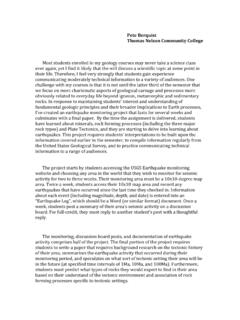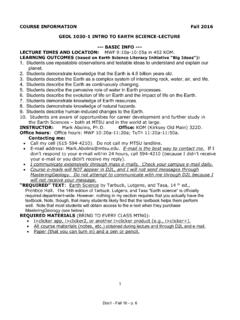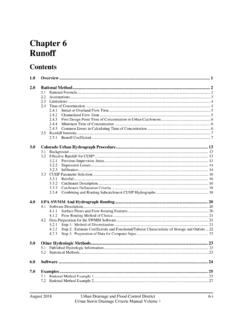Transcription of Basic Hydrology – Runoff Curve Numbers
1 Basic Hydrology Runoff Curve NumbersBy: Paul Schiariti, , CPESCM ercer County Soil Conservation DistrictThe SCS Runoff Curve Number The RCN ( Runoff Curve Number) method was originally established by the SCS in 1954. It was originally designed to be an Inter-Agency tool for the estimation of Runoff . It was therefore never subjected to peer or journal review by anyone outside the SCS Curve Number The CN was initially developed as a design tool to estimate Runoff from rainfall events on Agricultural fields. The sources of the original data are very obscure and difficult to verify. The method is now used as The method for computing peak Runoff rates and volumes for Urban Hydrology . TR-55 (Technical Release no. 55), a simplified NRCS tool essentially joins the NRCS Runoff equation with unit hydrograph theory for the computation of these Runoff What is it ? It is essentially a coefficient that reduces the total precipitation to Runoff potential, after losses Evaporation, Absorption, Transpiration, Surface Storage.
2 Therefore the higher the CN value the higher the Runoff potential will SCS Runoff EquationThe solution to this equation results in Runoff depth in watershed happens when you solve the SCS Runoff Equation for different CN Values and different Precipitation rates?Note: The initial Abstraction is greater than or equal to the Rainfall for values to the left of the red you plot the data from Table 2-1, P vs. Q, and you connect the points for each CN value you obtain a series of curves , thus the name Curve Number Ground Cover Conditions and the Proper Selection of CN sWith all of the ambiguity surrounding the origin and development of CN values, it is crucial to use the CN value that best mimics the Ground Cover Type and Hydrologic Runoff Curve Numbers for Cultivated Agricultural LandsTR-55 Runoff Curve Numbers for Other Agricultural LandsTR-55 Runoff Curve Numbers for Urban AreasLets take a look at an example:P = Space In Good ConditionHSG - "B"CN = 61250 much Runoff volume would be expected from this circumstance ?
3 Runoff Volume example (Continued) the Surface Storage:S = (1000 / CN) 10S = (1000 / 61 ) 10 = the Initial Abstraction:Ia= x SIa= x = the Runoff in Watershed Inches:Q = (P Ia)2/ (P Ia + S)Q = ( )2/ ( + )Q = Inches (Remember the original P= Inches) the Runoff Volume:V = [ In / (12 In / Ft)] x 250 Ft x 350 Ft =V = 9983 CFor 9983 CF / (43560 SF / Ac) = Ac-FtVPRECIP= [ In / (12 In / Ft)] x 250 Ft x 350 Ft = 36,458 CFTherefore the CN reduced the Precipitation Volume by 75%!Antecedent Moisture Condition (AMC)Antecedent Moisture condition is the preceding relative moisture of the pervious surfaces prior to the rainfall event. This is also referred to as Antecedent Runoff Condition (ARC).Antecedent Moisture is considered to be lowwhen there has been little preceding rainfall and highwhen there has been considerable preceding rainfall prior to the modeled rainfall modeling purposes, we consider watersheds to be AMC II, which is essentially an average moisture does Antecedent Moisture effect the CN Values ?
4 The Runoff Curve Number (RCN) can be adjusted for differing AMC based upon the above equations and :RCNII= 74 Compute RCNIand RCNIIRCNI= x 74= - x 74 RCNIII= 23 x 74= + x 74 Effect of Hydrologic Soil Group on Runoff Volumes and Peak Flow RatesErroneously using HSG A instead of HSG B for a Inch Rainfall on a Ac. Site, would cause an under-estimation of Runoff volume Inches CN67= 32,670 CF (Correct) Inches CN48= 10,709 CF (Incorrect)21,961 CF or 67%What is the Correct Curve Number ?The Soil is Reaville .Established Turf Grass is considered to be Open Space in Good Condition CN = 74 What is the Correct Curve Number ? (Photo from the Web Soil Survey)What is the Correct Curve Number ?This Agricultural Field is Soy Bean, planted in Straight rows and is the Correct Curve Number ?What is the Correct Curve Number ?This Agricultural Field is Sweet Corn planted in Straight RowsThis is what the field looks like during the non-growing is the Correct Curve Number ?
5 What is the Correct Cover Type and Treatment ?This is not Fallow!Terraced FieldsContoured FieldsContoured fields are plowed or planted parallel to the contour and perpendicular to the flow of is the Correct Cover Type / Description ?What is the Correct Cover Type / Description ?What is the Correct Cover Type / Description ?What is the Correct Cover Type / Description ?Is this a Pasture, a Meadow or Brush? It really depends on the use. If this plot is mowed for hay, it is a Meadow. If it is grazed, it would be considered a Pasture, grassland or range. If is just left as is it could be considered Brush-weeds-grass may have to do a little research to determine the proper classification. However if it is the pre-development analysis, and the smallest CN is surrendered it should be accepted!How much of a difference would the improper selection of a CN really make?Drainage Area is AcresTime of Concentration = HoursHydrologic Soil Group = BCN Pasture= 61CN Meadow= 58CN Brush= 48P2= InchesP10= InchesP100= InchesCompute the Peak Discharge Rates for the 2, 10, and 100 Year Storm much of a difference would the improper selection of a CN really make?
6 10 Year Storm Peak Discharge RatesHow much of a difference would the improper selection of a CN really make?100 Year Storm Peak Discharge RatesSummary:1. Always field verify the Pre-Development Ground Cover and If the analysis under estimates pre-development Curve Numbers , the analysis is Conservative .3. If the analysis over estimates pre-development Curve Numbers , the analysis is Incorrect .4. Understand the differences / subtleties in the Cover types for agricultural lands and cultivated agricultural Make sure the correct HSG is being If you disagree with a CN selection, understand how much of an effect it may have on the analysis.

















